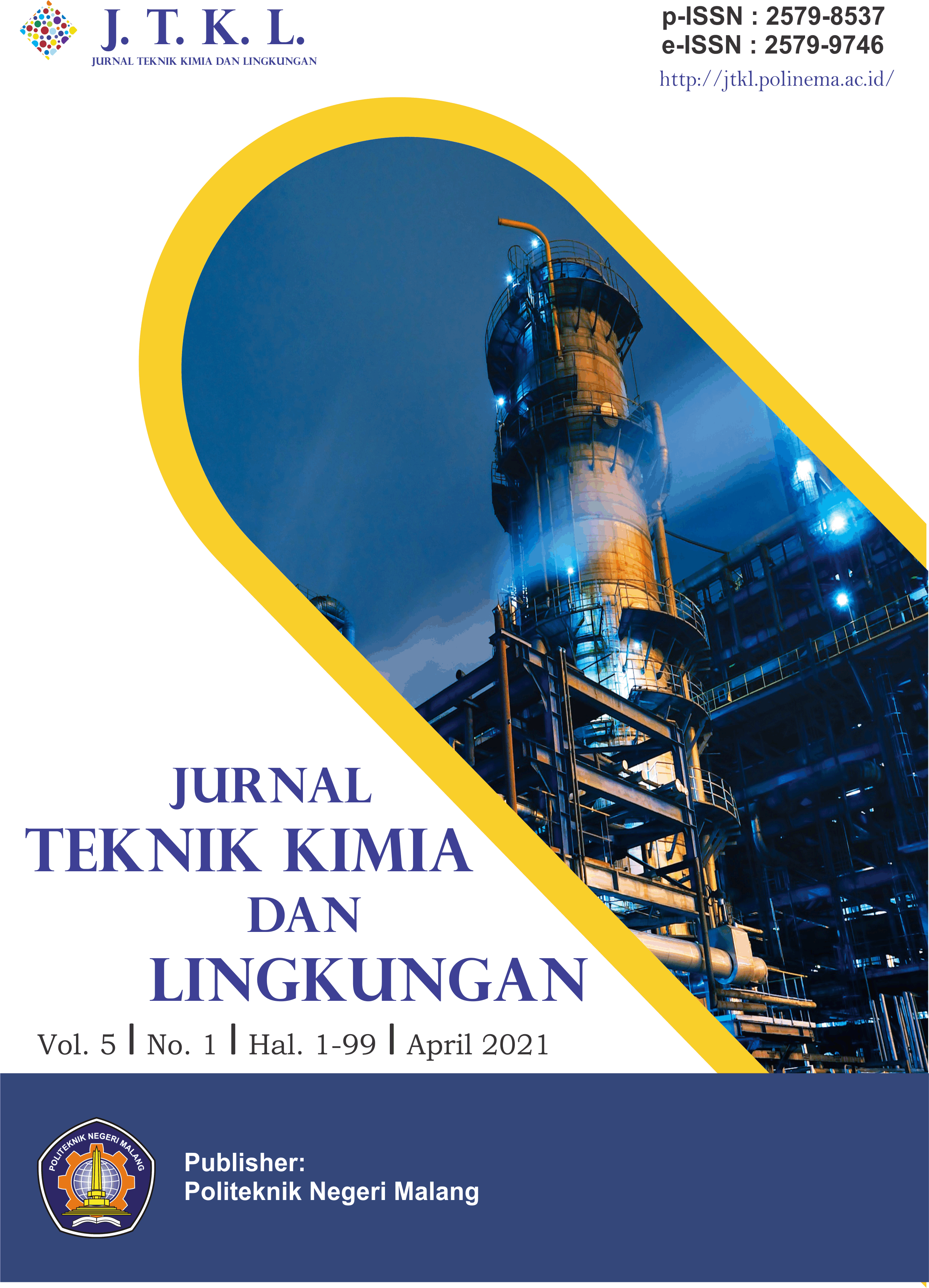Struvite Crystallization for Ammonium Removal from Cow Urine with Bulkhead Reactor
DOI:
https://doi.org/10.33795/jtkl.v5i1.202Keywords:
cow urine, struvite, ammonium removalAbstract
The presence of ammonium content in cow urine waste damages the aquatic ecosystem due to its toxicity. Ammonium content can be reduced by removing it through struvite crystallization. In this study, struvite (MgNH4PO4.6H2O) was formed from the reaction of magnesium, ammonium, and phosphate compounds using a bulkhead reactor. The rate of air moving the solution in the reactor causes ammonium to react with reactants to form struvite. This research was conducted with M : A : P (magnesium ammonium phosphate) molar ratio solution is 3 : 1 : 1 and 0,4 L/min air flow rate with MAP flow rate variation of 8,8; 11; 14,67; 22; 44 ml/min and a temperature variation of 25, 35, 45, 55, 65 ̊C to decrease ammonium content. The faster the MAP flow rate, the
lower the ammonium removal efficiency. The efficiency of ammonium removal will increase with increasing temperature. The best results obtained in this study were ammonium removal in the waste of 77.97%. The result of x-ray powder diffraction (XRD) and scanning electron microscope (SEM) is the crystals tested was a struvite with elongated or rod shape. EDAX analysis gave the percentage of components in struvite, namely 14.28% Mg, 10.68% N, and 18.19% P.
References
D. Pinardi, A. Gunarto, Santoso, Perencanaan Lanskap Kawasan Penerapan Inovasi Teknologi Peternakan Prumpung Berbasis Ramah Lingkungan, J. Ilm. Peternak. Terpadu, vol. 7, no. 2, pp. 251–262, 2019.
D. D. Saputro, B. R. Wijaya,Y. Wijayanti, Pengelolaan Limbah Peternakan Sapi Untuk Meningkatkan Kapasitas Produksi Pada Kelompok Ternak Patra Sutera, Rekayasa, vol. 12, no. 2, pp. 91–98, 2014.
H. A. Aka, Suhendrayatna, Syaubari, Penurunan Kadar Amonia Dalam Limbah Cair Oleh Tanaman Air Typha Latifolia ( Tanaman Obor ), J. Ilmu Kebencanaan, vol. 4, no. 3, pp. 72–75, 2017.
M. Prabhu and S. Mutnuri, Cow Urine as a Potential Source for Struvite Production, Int J Recycl Orf Waste Agric., vol. 3, no. 49, pp. 1–12, 2014.
X. Liu, J. Wang, Impact of calcium on struvite crystallization in the wastewater and its competition with magnesium, Chem. Eng. J., vol. 378, pp. 122121, 2019.
Sutiyono, L. Edahwati, K. Pratiwi A. Fanani, Tofu Factory Liquid Waste for Making Struvite with Canted Vertical Reactors, Int. J. Eco-Innovation Sci. Eng., vol. 1, no. 01, pp. 13–17, 2020.
E. Ariyanto, A. Melani, T. Anggraini, Penyisihan PO4 Dalam air Limbah Rumah Sakit Untuk Produksi Pupuk Struvite in Seminar Nasional Sains dan Teknologi, Fakultas Teknik Universitas Muhammadiyah Jakarta, November 2015.
K. S. Le Corre, Understanding Struvite Crystallisation and Recovery Supervisor, Ph.D Dissertation, Dept of Sustainable Systems, Centre for Water Science, School of Applied Science. Cranfield Univ, United Kingdom, 2006.
A. Pinalia, Kristalisasi Ammonium Perklorat (AP) dengan Sistem Pendinginan Terkontrol untuk Menghasilkan Kristal Berbentuk Bulat, J. Teknol. Dirgant., vol. 9, no. 2, pp. 124–131, 2011.
A. R. Fachry, J. Tumanggor, N. P. E. Y. L., Pengaruh Waktu Kristalisasi dengan Proses Pendinginan terhadap Pertumbuhan Kristal Amonium Sulfat dari Larutannya, J. Tek. Kim., vol. 15, no. 2, pp. 9–16, 2008.
E. Ariyanto, H. M. Ang, T. K. Sen, Impact of various physico-chemical parameters on spontaneous nucleation of struvite (MgNH4PO4.6H2O) formation in a wastewater treatment plant: kinetic and nucleation mechanism, Desalin. Water Treat., vol. 52, no. 34–36, pp. 6620–6631, Oct. 2014.
B. Li, H. M. Huang, I. Boiarkina, W. Yu, Y. F. Huang, G. Q. Wang, B. R.Young, Phosphorus recovery through struvite crystallisation : Recent developments in the understanding of operational factors, J. Environ. Manage., vol. 248, no. 109254, pp. 1-10, 2019.
Iswahyudi, L. K. Muharrami, Supriyanto, Pengolahan Limbah Garam (Bittern) menjadi Struvite dengan Pengontrolan pH, in Seminar Nasional : Menggagas Kebangkitan Komoditas Unggulan Lokal Pertanian dan Kelautan Fakultas Pertanian Universitas Trunojoyo Madura, 2013.
N. Ikhlas, Effect of pH, Molar Ratio, Precipitant Types, and Impurities Ions in Recovery of Ammonium and Phosphate for PT Petrokimia Gresik Wastewater Using Struvite Precipitation Method, Master thesis. Dept. of Environmental Engineering, Institut Teknologi Sepuluh Nopember Surabaya, Surabaya, Indonesia, 2017.
L. Edahwati, Sutiyono, N. Zahra, and H. Septiani, Magnesium Recovery of Struvite Formation Based on Waste Salts (Bittern) with a Bulkhead Reactor, Int. J. Eco-Innovation Sci. Eng., vol. 1, no. 1, pp. 1–5, 2020.
T. W. Puspitasari, Kinetika Reaksi Perolehan Phosphate dari Sintesa Mineral Struvite Menggunakan Reaktor Kolom Bersekat dengan Proses Sinambung, Undergraduate thesis, Chemical Engineering Study Program, Universitas Pembangunan Nasional Veteran Jawa Timur, Surabaya, Indonesia, 2019.
W. P. Iswarani, IDAA Warmadewanthi, Recovery Fosfat dan Amonium Menggunakan Teknik Presipitasi Struvite, J. Tek. ITS, vol. 7, no. 1, pp. 7–9, 2018.
L. Kinidi, I. A. W. Tan, N. B. Abdul Wahab, K. F. Bin Tamrin, C. N. Hipolito, S. F. Salleh, Recent Development in Ammonia Stripping Process for Industrial Wastewater Treatment, Int. J. Chem. Eng., vol. 2018, pp. 1-14, 2018
A. P. Bayuseno, W. W. Schmahl, Hydrothermal synthesis of struvite and its phase transition: Impacts of pH, heating and subsequent cooling methods, J. Cryst. Growth, vol. 498, pp. 336–345, 2018.
S. Guštin , R. Marinšek-Logar, Effect of pH, temperature and air flow rate on the continuous ammonia stripping of the anaerobic digestion effluent, Process Saf. Environ. Prot., vol. 89, no. 1, pp. 61–66, 2011.
I. Çelen, M. Türker, Recovery of ammonia as struvite from anaerobic digester effluents, Environ. Technol. (United Kingdom), vol. 22, no. 11, pp. 1263–1272, 2001.
M. Türker, I. Çelen, Removal of ammonia as struvite from anaerobic digester effluents and recycling of magnesium and phosphate, Bioresour. Technol., vol. 98, pp. 1529–1534, 2007.
M. M. Rahman, M. A. M. Salleh, U. Rashid, A. Ahsan, M. M. Hossain, C. S. Ra, Production of slow release crystal fertilizer from wastewaters through struvite crystallization - A review, Arab. J. Chem., vol. 7, no. 1, pp. 139–155, 2014.
M. I. Ali, Struvite crystallization from nutrient rich wastewater, Ph.D Dissertation, School of Engineering, James Cook University, 2005.
Downloads
Published
Issue
Section
License
Copyright (c) 2023 Luluk Edahwati, Sutiyono, Fauziah Hilda Alvira, Rizqi Rendri Anggriawan

This work is licensed under a Creative Commons Attribution-NonCommercial 4.0 International License.







